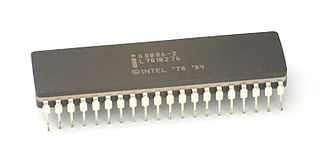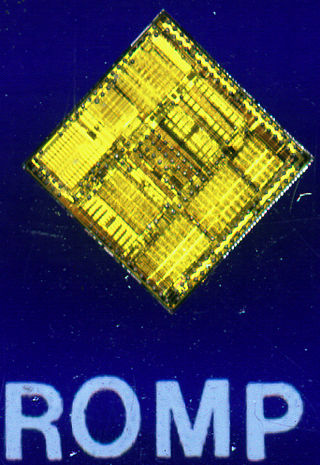Processor design is a subfield of computer science and computer engineering (fabrication) that deals with creating a processor, a key component of computer hardware.
In processor design, microcode serves as an intermediary layer situated between the central processing unit (CPU) hardware and the programmer-visible instruction set architecture of a computer, also known as its machine code. It consists of a set of hardware-level instructions that implement the higher-level machine code instructions or control internal finite-state machine sequencing in many digital processing components. While microcode is utilized in Intel and AMD general-purpose CPUs in contemporary desktops and laptops, it functions only as a fallback path for scenarios that the faster hardwired control unit is unable to manage.

In electronics and computer science, a reduced instruction set computer (RISC) is a computer architecture designed to simplify the individual instructions given to the computer to accomplish tasks. Compared to the instructions given to a complex instruction set computer (CISC), a RISC computer might require more instructions in order to accomplish a task because the individual instructions are written in simpler code. The goal is to offset the need to process more instructions by increasing the speed of each instruction, in particular by implementing an instruction pipeline, which may be simpler to achieve given simpler instructions.

x86 is a family of complex instruction set computer (CISC) instruction set architectures initially developed by Intel based on the 8086 microprocessor and its 8-bit-external-bus variant, the 8088. The 8086 was introduced in 1978 as a fully 16-bit extension of 8-bit Intel's 8080 microprocessor, with memory segmentation as a solution for addressing more memory than can be covered by a plain 16-bit address. The term "x86" came into being because the names of several successors to Intel's 8086 processor end in "86", including the 80186, 80286, 80386 and 80486. Colloquially, their names were "186", "286", "386" and "486".
In computer science, an instruction set architecture (ISA) is an abstract model that generally defines how software controls the CPU in a computer or a family of computers. A device or program that executes instructions described by that ISA, such as a central processing unit (CPU), is called an implementation of that ISA.
ARM is a family of RISC instruction set architectures (ISAs) for computer processors. Arm Holdings develops the ISAs and licenses them to other companies, who build the physical devices that use the instruction set. It also designs and licenses cores that implement these ISAs.
The Motorola 68000 series is a family of 32-bit complex instruction set computer (CISC) microprocessors. During the 1980s and early 1990s, they were popular in personal computers and workstations and were the primary competitors of Intel's x86 microprocessors. They were best known as the processors used in the early Apple Macintosh, the Sharp X68000, the Commodore Amiga, the Sinclair QL, the Atari ST and Falcon, the Atari Jaguar, the Sega Genesis and Sega CD, the Philips CD-i, the Capcom System I (Arcade), the AT&T UNIX PC, the Tandy Model 16/16B/6000, the Sun Microsystems Sun-1, Sun-2 and Sun-3, the NeXT Computer, NeXTcube, NeXTstation, and NeXTcube Turbo, early Silicon Graphics IRIS workstations, the Aesthedes, computers from MASSCOMP, the Texas Instruments TI-89/TI-92 calculators, the Palm Pilot, the Control Data Corporation CDCNET Device Interface, the VTech Precomputer Unlimited and the Space Shuttle. Although no modern desktop computers are based on processors in the 680x0 series, derivative processors are still widely used in embedded systems.

In computer architecture, 64-bit integers, memory addresses, or other data units are those that are 64 bits wide. Also, 64-bit central processing units (CPU) and arithmetic logic units (ALU) are those that are based on processor registers, address buses, or data buses of that size. A computer that uses such a processor is a 64-bit computer.
In computer science, computer engineering and programming language implementations, a stack machine is a computer processor or a virtual machine in which the primary interaction is moving short-lived temporary values to and from a push down stack. In the case of a hardware processor, a hardware stack is used. The use of a stack significantly reduces the required number of processor registers. Stack machines extend push-down automata with additional load/store operations or multiple stacks and hence are Turing-complete.
Addressing modes are an aspect of the instruction set architecture in most central processing unit (CPU) designs. The various addressing modes that are defined in a given instruction set architecture define how the machine language instructions in that architecture identify the operand(s) of each instruction. An addressing mode specifies how to calculate the effective memory address of an operand by using information held in registers and/or constants contained within a machine instruction or elsewhere.
In computer engineering, out-of-order execution is a paradigm used in high-performance central processing units to make use of instruction cycles that would otherwise be wasted. In this paradigm, a processor executes instructions in an order governed by the availability of input data and execution units, rather than by their original order in a program. In doing so, the processor can avoid being idle while waiting for the preceding instruction to complete and can, in the meantime, process the next instructions that are able to run immediately and independently.
The AT&T Hobbit is a microprocessor design developed by AT&T Corporation in the early 1990s. It was based on the company's CRISP design resembling the classic RISC pipeline, and which in turn grew out of the C Machine design by Bell Labs of the late 1980s. All were optimized for running code compiled from the C programming language. The design concentrates on fast instruction decoding, indexed array access, and procedure calls.

The AMD Am29000, commonly shortened to 29k, is a family of 32-bit RISC microprocessors and microcontrollers developed and fabricated by Advanced Micro Devices (AMD). Based on the seminal Berkeley RISC, the 29k added a number of significant improvements. They were, for a time, the most popular RISC chips on the market, widely used in laser printers from a variety of manufacturers.

The ROMP is a reduced instruction set computer (RISC) microprocessor designed by IBM in the late 1970s. It is also known as the Research OPD Miniprocessor and 032. The ROMP was originally developed for office equipment and small computers, intended as a follow-on to the mid-1970s IBM OPD Mini Processor microprocessor, which was used in the IBM Office System/6 word-processing system. The first examples became available in 1981, and it was first used commercially in the IBM RT PC announced in January 1986. For a time, the RT PC was planned to be a personal computer, with ROMP replacing the Intel 8088 found in the IBM Personal Computer. However, the RT PC was later repositioned as an engineering and scientific workstation computer. A later CMOS version of the ROMP was first used in the coprocessor board for the IBM 6152 Academic System introduced in 1988, and it later appeared in some models of the RT PC.

V850 is a 32-bit RISC CPU architecture produced by Renesas Electronics for embedded microcontrollers. It was designed by NEC as a replacement for their earlier NEC V60 family, and was introduced shortly before NEC sold their designs to Renesas in the early 1990s. It has continued to be developed by Renesas as of 2018.
Minimal instruction set computer (MISC) is a central processing unit (CPU) architecture, usually in the form of a microprocessor, with a very small number of basic operations and corresponding opcodes, together forming an instruction set. Such sets are commonly stack-based rather than register-based to reduce the size of operand specifiers.

The R4000 is a microprocessor developed by MIPS Computer Systems that implements the MIPS III instruction set architecture (ISA). Officially announced on 1 October 1991, it was one of the first 64-bit microprocessors and the first MIPS III implementation. In the early 1990s, when RISC microprocessors were expected to replace CISC microprocessors such as the Intel i486, the R4000 was selected to be the microprocessor of the Advanced Computing Environment (ACE), an industry standard that intended to define a common RISC platform. ACE ultimately failed for a number of reasons, but the R4000 found success in the workstation and server markets.

The history of general-purpose CPUs is a continuation of the earlier history of computing hardware.

The Alpha 21064 is a microprocessor developed and fabricated by Digital Equipment Corporation that implemented the Alpha instruction set architecture (ISA). It was introduced as the DECchip 21064 before it was renamed in 1994. The 21064 is also known by its code name, EV4. It was announced in February 1992 with volume availability in September 1992. The 21064 was the first commercial implementation of the Alpha ISA, and the first microprocessor from Digital to be available commercially. It was succeeded by a derivative, the Alpha 21064A in October 1993. This last version was replaced by the Alpha 21164 in 1995.
RISC-V is an open standard instruction set architecture (ISA) based on established reduced instruction set computer (RISC) principles. The project began in 2010 at the University of California, Berkeley, transferred to the RISC-V Foundation in 2015, and on to RISC-V International, a Swiss non-profit entity, in November 2019. Like several other RISC ISAs, e.g. Amber (ARMv2) or OpenRISC, RISC-V is offered under royalty-free open-source licenses. The documents defining the RISC-V instruction set architecture (ISA) are offered under a Creative Commons license or a BSD License.









